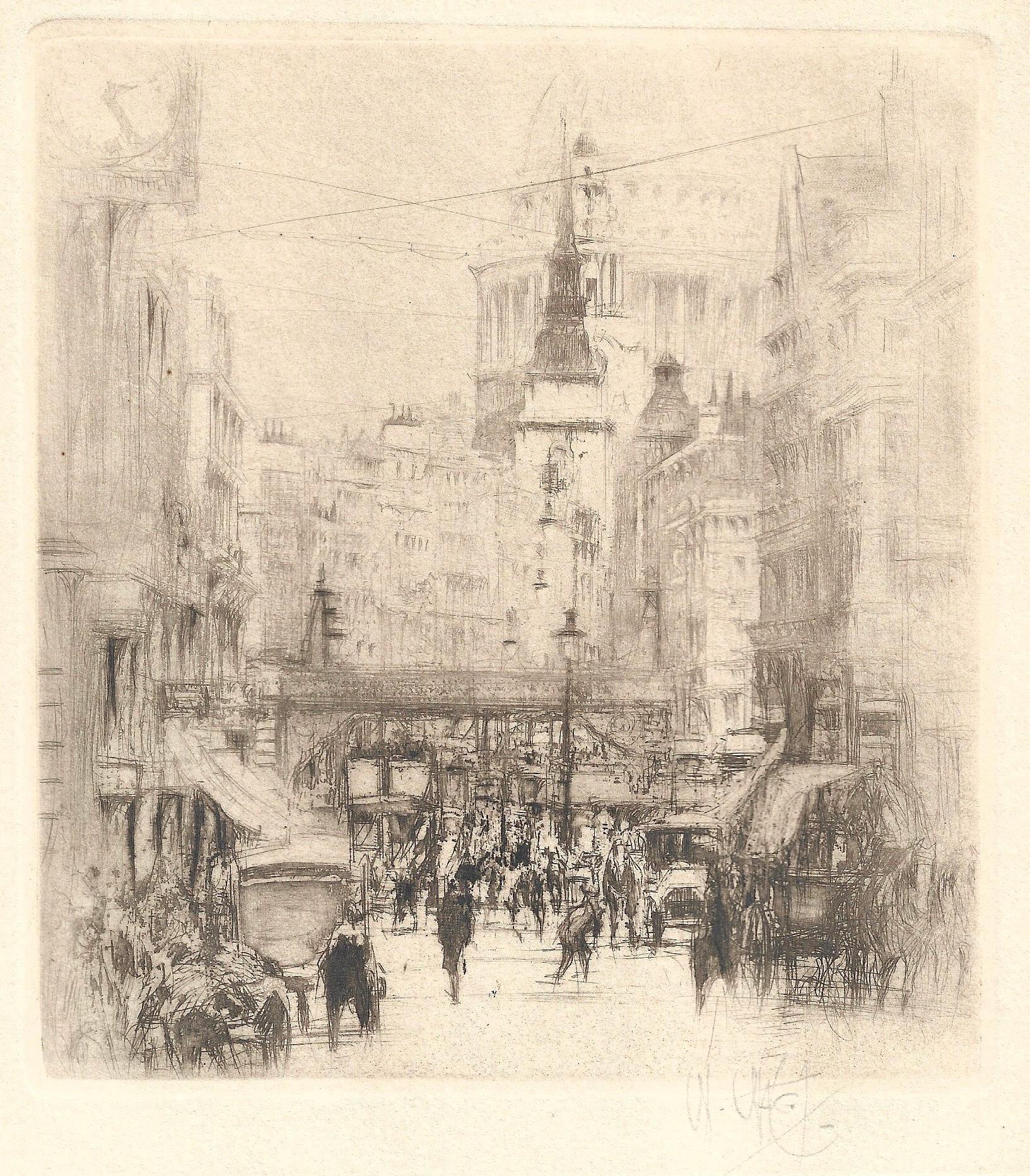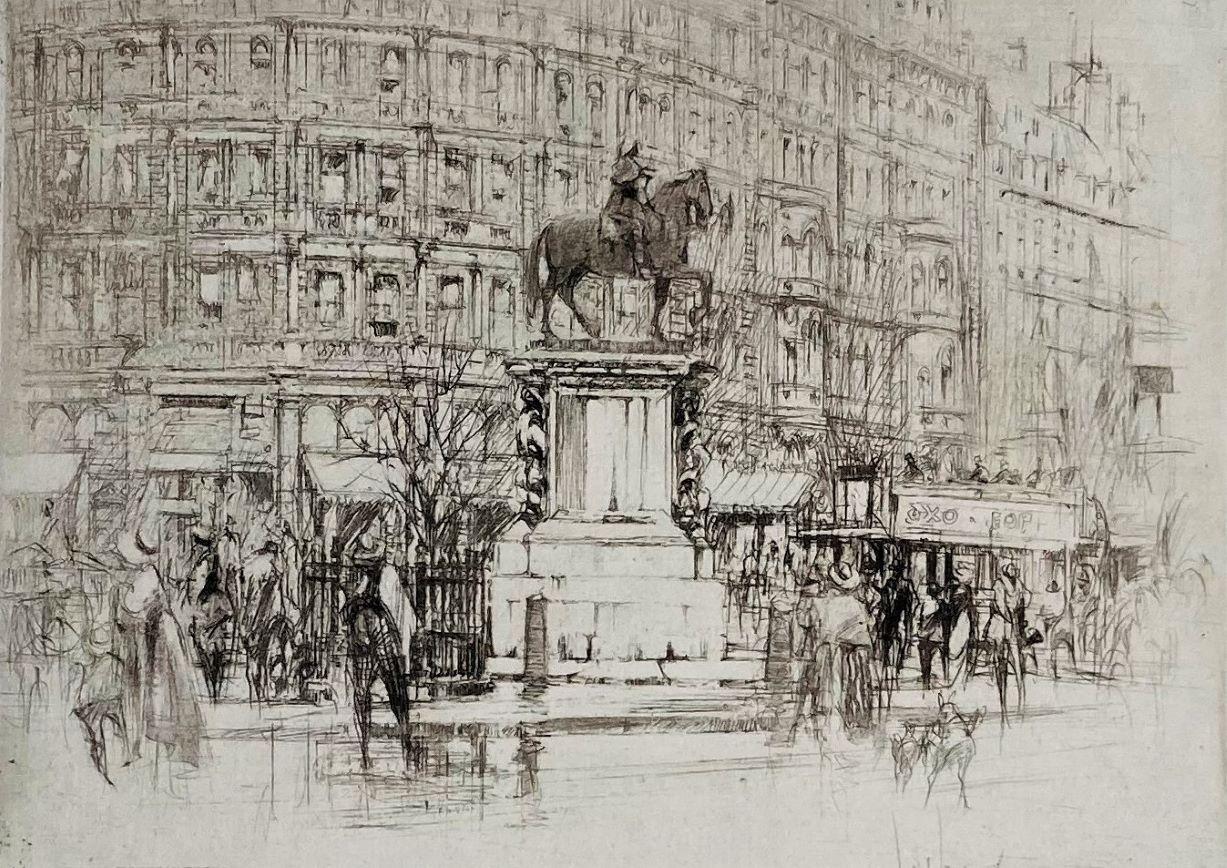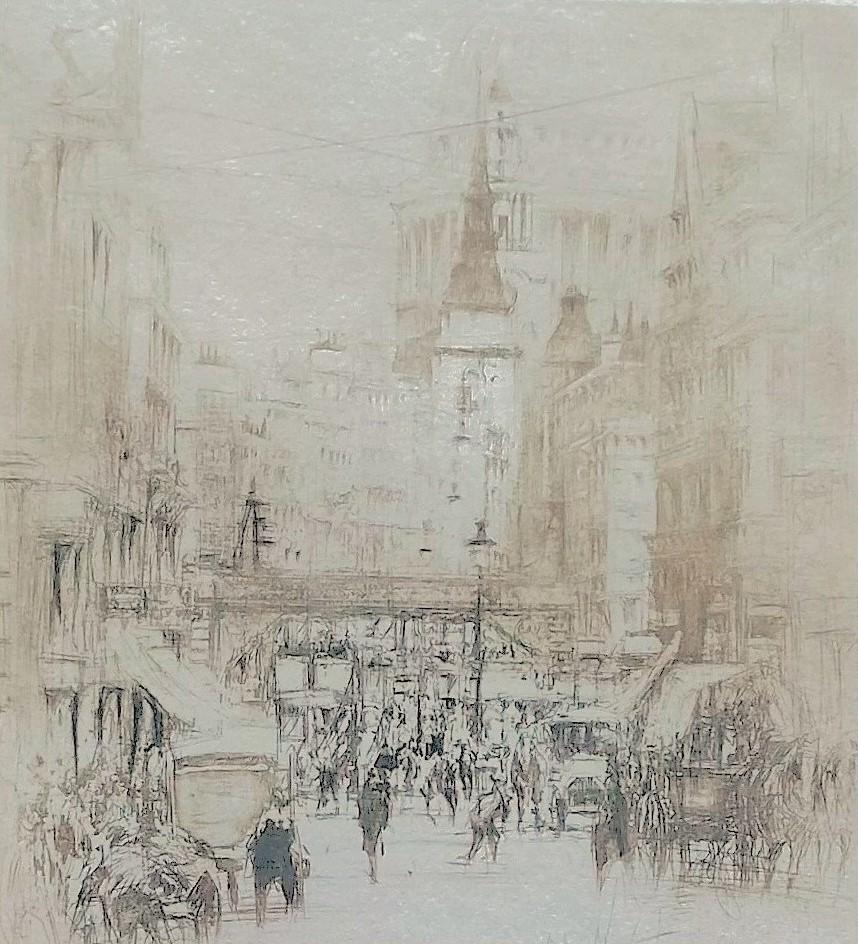Items Similar to Boston
Want more images or videos?
Request additional images or videos from the seller
1 of 8
John William HillBoston1857
1857
About the Item
John William Hill (1812-1879)
"Boston" 1857
Hand-Colored Engraving
Site Size: 29 x 41 inches
Framed Size: 39 x 52 inches
Born in London, England, John William Hill came to America with his family at age 7. His father, John Hill, was a well-known landscape painter, engraver, and aquatintist. John William had a career of two phases, a city topographer-engraver and then, the leading pre-Rafaelite school painter in this country. Employed by the New York Geological Survey and then by Smith Brothers in New York City, he did lithographs of cities, private residences and public buildings.
In 1855 at age 43, he became involved with the Pre-Rafaelite movement led by Englishman, John Ruskin. This aesthetic philosophy was a turning away from academic strictures to the purity of art before Rafael--focus on the uplifting qualities of art through natural setting landscapes, meticulous observation of nature, and bright colors on a wet ground. The bright, luminous qualities with detailed form contrasted with the sombre prevailing works of the time.
Hill worked mainly in New Jersey and along the Hudson River Valley but also was in the White Mountains of New Hampshire in 1852 and 1857 and in 1852 did a view of Richmond, Virginia that was published by Smith and Brothers.
Written by Lonnie Dunbier
Source:
David Michael Zellman, "300 Years of American Art"
Peter Falk, "Who Was Who in American Art"
- Creator:John William Hill (1812 - 1879, American)
- Creation Year:1857
- Dimensions:Height: 39 in (99.06 cm)Width: 52 in (132.08 cm)Depth: 1 in (2.54 cm)
- Medium:
- Movement & Style:Pre-Raphaelite
- Period:
- Condition:
- Gallery Location:Missouri, MO
- Reference Number:1stDibs: LU74735193661
About the Seller
5.0
Vetted Seller
These experienced sellers undergo a comprehensive evaluation by our team of in-house experts.
Established in 1970
1stDibs seller since 2017
142 sales on 1stDibs
Typical response time: 21 hours
- ShippingRetrieving quote...Ships From: Missouri, MO
- Return PolicyA return for this item may be initiated within 2 days of delivery.
More From This SellerView All
- In BrittanyBy Manuel RobbeLocated in Missouri, MOColor Engraving Image Size: approx 14 x 19.5 Framed Size: approx 21 x 26 3/4 Signed in Pencil Emmanuel Robbe called "Manuel Robbe", born in Paris on 16 December 1872 And died in Ne...Category
Early 1900s Impressionist Figurative Prints
MaterialsAquatint, Engraving
- Canyon Road, Sante FeBy Will (William Howard) ShusterLocated in Missouri, MOCanyon Road, Santa Fe By. William Howard Shuster (American, 1893-1969) Signed Lower Right Edition of 100 Lower Center Titled Lower Left Unframed: 4" x 4.75" Framed: 15.75" x 15.25" A realist and early modernist painter, graphic artist, illustrator, and sculptor, Will Shuster became known primarily for his work in New Mexico where in 1920, he settled in Santa Fe, having been encouraged to come there by John Sloan. He had studied electrical engineering at the Drexel Institute in Philadelphia and later was a student of Sloan's in Santa Fe in both etching and painting. He was in World War I, where he suffered a gas attack. On his return, he studied with J William Server in Philadelphia but was advised to go West for his health. In Santa Fe in 1921, he became one of the founding members of Los Cinco Pintores...Category
20th Century American Modern Landscape Prints
MaterialsEtching
- Bataille de Fleurs (Carnaval of Flowers) from Nice and the Côte d’AzurBy Marc ChagallLocated in Missouri, MOMarc Chagall (1887 - 1985) "Bataille de Fleurs (Carnaval of Flowers)" (from Nice and the Côte d’Azur), 1967 Reference: CS 33 Color Lithograph Image Size: 24 7/16 in x 18 in (62 cm x 45.8 cm) Sheet Size: 29 9/16 in x 20 11/16 in (75 x 52.5 cm) Framed Size: approx. 34 x 27 inches Edition: Numbered 7 of 150 in pencil in the lower left margin and printed on Arches wove paper (aside from an edition of 75 signed and numbered in Roman numerals and 10 artist's proofs). Signature: This work is hand signed by Marc Chagall (Vitebsk, 1887 - Saint-Paul, 1985) in pencil in the lower right margin. Marc Chagall was a man of keen intelligence, a shrewd observer of the contemporary scene, with a great sympathy for human suffering. He was born on July 7, 1887 in Vitebsk, Russia; his original name was Moishe Shagal (Segal), but when he became a foremost member of the Ecole de Paris, he adopted French citizenship and the French spelling of his name. Vitebsk was a good-sized Russian town of over 60,000, not a shtetl. His father supported a wife and eight children as a worker in a herring-pickling plant. Sheltered by the Jewish commandment against graven images, the young Chagall never saw so much as a drawing until, one day, he watched a schoolmate copying a magazine illustration. He was ridiculed for his astonishment, but he began copying and improvising from magazines. Both Chagall's parents reluctantly agreed to let him study with Yehuda Pen, a Jewish artist in Vitebsk. Later, in 1906, they allowed their son to study in St. Petersburg, where he was exposed to Russian Iconography and folk art. At that time, Jews could leave the Pale only for business and employment and were required to carry a permit. Chagall, who was in St. Petersburg without a permit, was imprisoned briefly. His first wife, Bella Rosenfeld, was a product of a rich cultivated and intellectual group of Jews in Vitebsk. Chagall was made commissar for the arts for the area, charged with directing its cultural life and establishing an art school. Russian folklore, peasant life and landscapes persisted in his work all his life. In 1910 a rich patron, a lawyer named Vinaver, staked him to a crucial trip to Paris, where young artists were revolutionizing art. He also sent him a handsome allowance of 125 francs (in those days about $24) each month. Chagall rejected cubism, fauvism and futurism, but remained in Paris. He found a studio near Montparnasse in a famous twelve-sided wooden structure divided into wedge-shaped rooms. Chaim Soutine, a fellow Russian Jew...Category
1960s Modern Figurative Prints
MaterialsLithograph
- Cove at VintageBy LeRoy NeimanLocated in Missouri, MOCove at Vintage Leroy Neiman (American, 1921-2012) Signed in pencil lower right Edition 237/375 lower left 34 x 36.5 inches 43 x 45.5 inches with frame Known for his bright, colorfu...Category
20th Century American Modern Landscape Prints
MaterialsColor, Lithograph
- U.S. Open at OakmontBy LeRoy NeimanLocated in Missouri, MOU.S. Open at Oakmont Leroy Neiman (American, 1921-2012) Signed in pencil lower right Edition 63/300 lower left 27.5 x 39 inches 39.25 x 51 inches with frame Known for his bright, co...Category
20th Century American Modern Landscape Prints
MaterialsColor, Lithograph
- The 18th at Pebble BeachBy LeRoy NeimanLocated in Missouri, MOThe 18th at Pebble Beach Leroy Neiman (American, 1921-2012) Signed in pencil lower right Edition 176/400 lower left 26 x 43 inches 37.25 x 54.5 inches with frame Known for his brigh...Category
20th Century American Modern Landscape Prints
MaterialsColor, Lithograph
You May Also Like
- Ludgate HillBy William Walcot R. E. Hon. R. I. B. A.Located in Middletown, NYEtching with drypoint and aquatint on light cream wove paper, 5 1/2 x 5 inches (140 x 122 mm), full margins. Signed in pencil in the lower margin. One of a total of 400 signed impres...Category
Early 20th Century Modern Landscape Prints
MaterialsDrypoint, Etching, Aquatint
- Chelsea Old Church, LondonBy William Walcot R. E. Hon. R. I. B. A.Located in Storrs, CTChelsea Old Church. 1924. Etching, drypoint, and aquatint. Dickins 94. 5 3/8 x 8 (sheet 8 1/2 x 9 3/4). Edition 100 for The Print Collector's Club. A fine proof with tonal wiping, printed on cream wove paper. Signed and dedicated "W.R. Button from W. Walcot London 1930" in pencil. Chelsea Old Church, also known as All Saints, is an Anglican church, on Old Church Street, Chelsea, London SW3, England, near Albert Bridge. It is the church for a parish in the Diocese of London, part of the Church of England. Inside the Grade I listed building, there is seating for 400 people. There is a memorial plaque to the author Henry James (1843–1916) who lived nearby on Cheyne Walk. To the west of the church is a small public garden containing a sculpture by Sir Jacob Epstein. When he was seventeen,William Walcot began to study architecture under Louis Benois at the Imperial Academy of Art in Saint Petersburg. He went to Paris where he continued his studies at the Ecole des Beaux-Arts and the Atelier Redon. He practiced as an architect briefly in Moscow, designing the Hotel Metropole...Category
Early 20th Century Modern Landscape Prints
MaterialsDrypoint, Etching, Aquatint
- Charing Cross - The Statue of Charles I.By William Walcot R. E. Hon. R. I. B. A.Located in Storrs, CTCharing Cross -- The Statue of Charles I. 1919. Etching with aquatint and drypoint. 3 5/8 x 4 7/8 (sheet 9 1/8 x 11 3/8). A fine proof with tonal wiping, printed on cream-wove paper. Signed in pencil. Charing Cross is located at the junction of the Strand, Whitehall, and Cockspur Street in Central London, England. The name originates from the Eleanor cross installed by King Edward I as a memorial to his wife, Eleanor of Castile at the former hamlet of Charing. Since 1675, the cross site has been occupied by a statue of King Charles I mounted on a horse. The pedestal is thought to be designed by Wren and carved by Grinling Gibbons. Chelsea Old Church, also known as All Saints, is an Anglican church, on Old Church Street, Chelsea, London SW3, England, near Albert Bridge. It is the church for a parish in the Diocese of London, part of the Church of England. Inside the Grade I listed building, there is seating for 400 people. There is a memorial plaque to the author Henry James (1843–1916) who lived nearby on Cheyne Walk. To the west of the church is a small public garden containing a sculpture by Sir Jacob Epstein. When he was seventeen,William Walcot began to study architecture under Louis Benois at the Imperial Academy of Art in Saint Petersburg. He went to Paris where he continued his studies at the Ecole des Beaux-Arts and the Atelier Redon. He practiced as an architect briefly in Moscow, designing the Hotel...Category
Early 20th Century Modern Landscape Prints
MaterialsDrypoint, Etching, Aquatint
- The First Wooden Temple of JupiterBy William Walcot R. E. Hon. R. I. B. A.Located in Storrs, CTThe First Wooden Temple of Jupiter or Restoration of one of the first Temples of Jupiter Capitolinus, Rome.Dickins 47. 5 1/8 x 7 1/8 (sheet 9 3/16 x 11 5...Category
Early 20th Century Modern Landscape Prints
MaterialsDrypoint, Etching, Aquatint
- San Marco [Venice].By William Walcot R. E. Hon. R. I. B. A.Located in Storrs, CTWilliam Walcot. R.E., R.I.B.A. San Marco. Etching with drypoint and aquatint. Dickins 66, Harvey-Lee 91. 3 7/8 x 5 7/8 (sheet 9 1/4 x 12 1/8). Venice set, # 2. Edition 415. A rich impression printed on cream wove paper. Fold in the margin, well outside the image; otherwise good condition. Signed in pencil. Housed in a 16 x 20-inch archival mat. Soon after Walcot's arrival in England, the Fine Art Society sponsored a trip sent to Italy. This scene is one of four small drypoints that resulted from the artist’s stay in Venice. When he was seventeen, he began to study architecture under Louis Benois at the Imperial Academy of Art in Saint Petersburg. He went to Paris where he continued his studies at the Ecole des Beaux-Arts and the Atelier Redon. He practiced as an architect briefly in Moscow, designing the Hotel Metropole...Category
Early 20th Century Modern Landscape Prints
MaterialsDrypoint, Etching, Aquatint
- Ludgate HillBy William Walcot R. E. Hon. R. I. B. A.Located in Storrs, CTLudgate Hill. 1921. Etching, aquatint, and drypoint. Dickins 69. 5 5/8 x 5 1/8 (sheet 13 5/8 x 9 3/4). A fine proof with plate tone, printed on 'J Wha[tman] cream wove paper. Edition of 275 for the UK and 125 for the US. Signed in pencil. Ludgate Hill is a street that runs west from St. Paul's Churchyard to Ludgate Circus (built in 1864), and from there becomes Fleet Street. The Ludgate Hill railway station, between Water Lane and New Bridge Street, is a station of the London, Chatham, and Dover Railway. It was closed before World War II and the railway bridge and viaduct between Holborn Viaduct and Blackfriars stations was demolished in 1990 to enable the construction of the City Thameslink railway station in a tunnel. This also involved the regrading of the slope of Ludgate Hill at the junction. About halfway up Ludgate Hill is St Martin, Ludgate church. This was physically joined to the Ludgate. When he was seventeen, William Walcot began to study architecture under Louis Benois at the Imperial Academy of Art in Saint Petersburg. He went to Paris where he continued his studies at the Ecole des Beaux-Arts and the Atelier Redon. He practiced as an architect briefly in Moscow, designing the Hotel...Category
Early 20th Century Modern Landscape Prints
MaterialsDrypoint, Etching, Aquatint
Recently Viewed
View AllMore Ways To Browse
Antique Boston
New Hampshire Antique
Antique Geology
Hudson Valley Antique
White Mountains New Hampshire
The Englishman
Michael John Hill
Grandmothers Flower Garden Quilt
Gwenda Morgan
Harold L Doolittle
Heine Hartwig
Hercules Seghers
Hiroshige Chiryu
Hogarth Times Of Day
Ito Takashi
Ivan Agueli
Jacob Crook
Jessica Dunne




![San Marco [Venice].](https://a.1stdibscdn.com/william-walcot-prints-works-on-paper-san-marco-venice-for-sale/a_3352/a_101504721690399029260/sanmarcoimage3_master.jpg)
